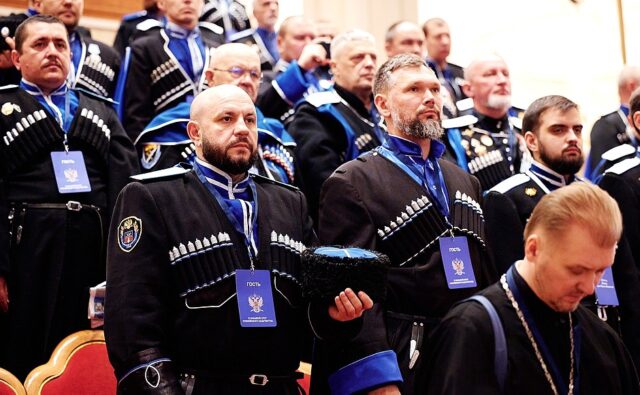
Moscow Uses Cossacks to Feign Interethnic Harmony in Russia
Publication: Eurasia Daily Monitor Volume: 21 Issue: 97
By:

Executive Summary:
- The Kremlin is increasingly relying on the state-registered Cossack movement to feign interethnic harmony and national unity in Russia, pushing back against reports of growing social unrest throughout the country.
- While the Cossacks are touted as rising above ethnic differences, some still promote xenophobic messaging and resentment against other ethnic groups at the grassroots level.
- The proclaimed role of Cossacks loyal to the Kremlin in promoting interethnic unity while alienating certain ethnically non-Russian groups hides the uglier reality of growing societal and interethnic strife throughout Russia.
Following the recent attacks in Dagestan and the earlier Crocus City Hall attack in March, Moscow has leaned on the state-registered Cossack movement to try to harmonize interethnic relations (see EDM, February 27, March 26, 27, 28, June 25). On June 12, Cossack leader Vitaly Kuznetsov promoted this message and praised the Cossacks’ “unique historical experience” in maintaining relations with other ethnic groups throughout Russia. In April, Kuznetsov was inducted to the Presidential Council for Interethnic Relations by presidential decree, indicating that his recent pronouncement comes at the Kremlin’s direction. He went on to praise the role of Muslim and Buddhist volunteers in the Terek Cossack unit, suggesting the war in Ukraine has, to some degree, mended regional and interreligious differences in Russia (Vsko.ru, June 12). The state-registered Cossack movement and its “appeal” to rise above ethnic differences has become the cornerstone of Moscow’s efforts to feign national unity amid growing social unrest and interethnic strife. This forms the core of the claim that today, “the Cossack movement is the strongest noncommercial social organization in Russia” (Vsko.ru, June 21).
The Soviet victory in the “Great Patriotic War” (World War II) is one of the most revered historical events in Russia and perhaps the closest the country has come to a unifying civic religion. Cossacks played a central role in this year’s Victory Day celebrations throughout Russia:
- Over 9,000 Cossacks attended and took part in the Victory Day parade on Red Square (ru, May 5).
- Cossack groups helped promote festivities throughout Russia, including the “Great Victory Run.” During the event, the Union of Cossack Youth of Russia and the “Ataman” youth Cossack club hosted 1,418-meter races to symbolize the number of days in the war (Vsko.ru, May 6).
- In Samara, the “Cossack Hundred” and Cossack Cadets Corps of Samara State Technical University participated in the local parade (Volga Cossacks, May 3).
- In Kuzbass, Cossacks in the village of Prokopyevskaya organized “training sessions with light arms” for children and displayed relics of the Great Patriotic War (ru, May 6).
In May, the All-Russian Cossack Society website announced the opening of the exhibit, “The Main Tradition of the Russian Cossacks: Defend the Motherland.” It is designed to show how Cossacks have taken up arms for the country “from the birth of the Cossacks to the present day,” with an emphasis on the role of Cossack cavalry in the liberation of Crimea in 1943 (Vsko.ru, May 7). Additionally, the physical exhibit “Cossacks in Defense of the Fatherland’s Borders” was opened by the Russian State Library (Kazachestvo.ru, May 6). Finally, three members of the Orenburg Cossack Host received medals during Vladimir Putin’s inauguration (Vsko.ru, May 7). All this demonstrates the increased role of state-registered Cossacks in “consolidating” the Russian nation, despite reports of growing fractures within the Russian population.
Some Cossack Telegram channels paint a similar picture of interethnic harmony, while others portray quite a different view on local sentiments. On the one hand, one post details the visit of local singer Lyubov’a Rasskina to one of the mess halls of the Cossack Oskol detachment, where she and her troupe hosted an impromptu concert. In explaining her reasoning, Rasskina, sporting a T-shirt emblazoned with the letter “Z,” the icon for Moscow’s war against Ukraine, stated, “We came here to support our boys … like in the Great Patriotic War when they came to cheer the units of soldiers with a heartfelt song” (T.me/cossack_pika, May 4). Such actions and discourse attempt to paint a picture of the war bringing unity and harmony to Russia’s many ethnic and religious groups.
On the other hand, some Cossacks loyal to the Kremlin manifest grassroots resentment for other groups. A story recently shared on one Cossack Telegram channel tells of ten migrants from Tajikistan who were detained in Tyumen for having illicit materials on their phones (T.me/zoperation, May 3). The discussion on the post was full of xenophobic tropes, including calling migrants “savages” and suggesting that this was part of a larger plot to “sabotage” the Russian nation. Likewise, in May, Mikhail Matveev, a representative of the State Duma, declared that the arrival of more Tajik and Kyrgyz migrants to Russia was carried out “with the participation of the British and American governments,” ostensibly aiming to reduce poverty in Central Asia. Matveev contended, however, that the real goal was “a long-term plan to replace the Russian population with alien elements and create conditions for a sociocultural catastrophe” (T.me/zoperation, May 2). Criminal allegations have an important role in fanning interethnic hostilities, and the discussion featured threats of retaliatory violence and mocking questions such as “where is the ‘pedophilia has no nationality?’” Grassroots resentment among local Cossacks toward migrants casts doubts on their role in promoting “interethnic harmony.”
Such stories are consistent with reports of “retaliation” against ethnically non-Russian groups from ethnic Russians in the wake of the Crocus City Hall attack. The SOVA Center, a human rights agency monitoring far-right violence in Russia, has reported a sharp increase in violent attacks and hateful rhetoric since March. Under these circumstances, the proclaimed role of Cossacks loyal to the Kremlin in promoting interethnic unity while alienating certain ethnically non-Russian groups hides the uglier reality of growing societal and interethnic strife throughout Russia (Sova-centrer.ru, May 6).



